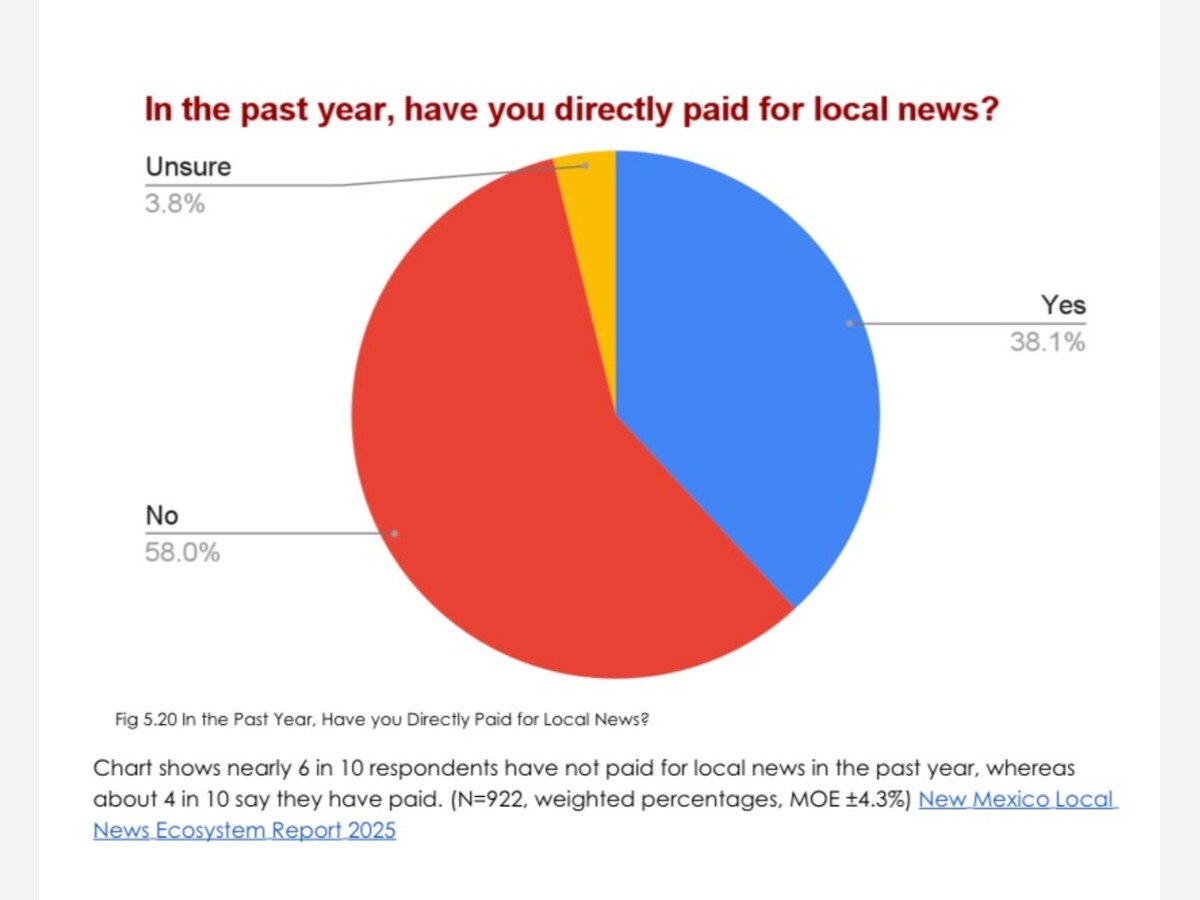Image


In a state where vast distances and diverse communities define daily life, New Mexicans are increasingly relying on social media to stay informed about local happenings, according to a comprehensive new report on the state’s news ecosystem. But the findings also highlight a growing crisis: two-thirds of residents feel they lack trustworthy local sources, underscoring the vital role of small-town independent media in bridging information deserts.
The “New Mexico Local News Ecosystem Report 2025,” released today by the NM Local News Fund and Press Forward New Mexico, paints a picture of a fragmented media landscape. Based on surveys of over 1,100 residents, content analyses of 139 news outlets—including small-town independents like AlamogordoTownNews.org, KALHRadio.org (which offers streaming and podcasts), and the Cloudcroft Reader—and focus groups across the state, the report reveals that social media has overtaken traditional platforms as the preferred way to get local news. Platforms like Facebook, Instagram, and YouTube are favored by a majority, with rural residents turning to them three times more often than TV or radio.
“Social media is the most preferred source of news for New Mexicans,” the report states. “Rural residents prefer social media three times as much as television or radio.” This shift reflects broader frustrations: 62% of respondents cited “not enough sources” as a barrier to accessing local news, while nearly 20% pointed to “distrust.” In focus groups, participants echoed this, with one Española resident lamenting, “It’s really hard to get quick, verified news — but it’s easy to get quick, unverified news.”
The digital divide is particularly acute in rural areas, where more than half of residents say they rarely or never find community-specific news on television. Instead, they lean on print newspapers and radio for reliability—64% report always or often getting trustworthy info from newspapers, and 48% from radio. Yet, the report warns that these traditional outlets are often small and under-resourced, with 90% of statewide newsrooms employing fewer than 10 full-time staff.
This scarcity amplifies the importance of independent, locally owned media in small towns. About 75% of New Mexico’s outlets are locally owned, bucking national trends of chain consolidations. However, nearly half are clustered in urban hubs like Albuquerque, Santa Fe, Las Cruces, and Farmington, leaving four counties with no local outlets and eight with just one. Residents in these “news deserts”—often rural, tribal, or Spanish-speaking communities—rely on distant Albuquerque-based sources or border-state TV from Texas, which lack local context.
“Four counties have no local news outlet based there,” the report notes, adding that gaps in coverage disproportionately affect Native American and Spanish-speaking populations. More than 500,000 New Mexicans speak Spanish at home, but only four outlets provide news in Spanish. Similarly, over 60,000 speak Diné (Navajo), with just three outlets serving them.
Focus group participants stressed the human element missing in broader coverage. “Include us in your reporting now and then — and not just for the bad things,” said a Las Cruces resident. “We have had great things happen in our communities.” The report echoes this, finding that 97% of New Mexicans view investigative journalism as very or somewhat important, and 84% want outlets to suggest solutions to local problems like education, health, housing, and government accountability.
Despite these demands, financial realities hinder progress. Over 80% of outlets operate on budgets under $500,000, and 58% of residents haven’t paid for local news in the past year. When asked about willingness to pay, nearly half said they’d contribute $1–$20 monthly for trusted, relevant content—but many expressed subscription fatigue.
The report’s authors, Michael V. Marcotte and Gwyneth Doland, call for targeted investments in small-town media to foster innovation and collaboration. “Every resident, no matter where they live, should have access to trusted local information,” said Rashad Mahmood, executive director of the NM Local News Fund. Recommendations include funding rural reporting, diversifying revenue models beyond ads, and building shared digital tools for multilingual content.
As New Mexico grapples with high poverty and cultural diversity, the report serves as a “call to innovate,” Mahmood added. With an interactive map at NMNewsMap.org, stakeholders can now visualize gaps and track progress, potentially guiding state policies like recent allocations for tribal radio.
For full details, visit the NM Local News Fund’s website. The report was funded by Press Forward New Mexico and partners including the UNM Center for Regional Studies.